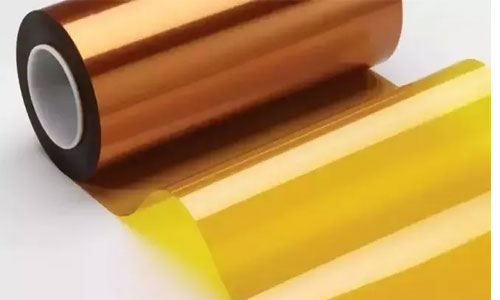High-temperature tape, also known as heat-resistant tape, is a type of adhesive tape used in high-temperature environments. It is commonly used in the electronics industry for applications such as painting, leather processing, coating masking, fixing electronic components, printing circuit boards, and high-temperature shielding.
There are various types of high-temperature tape available, including Kapton tape, PTFE tape, crepe paper tape, PET green tape, and double-sided tape.
(1) PTFE Tape
PTFE tape is mainly used for insulation wrapping in the wire and cable industry, insulation lining in the electrical industry, surface coating of storage tanks and rollers, friction lining for guide rails, and can be directly applied to various flat and regular curved surfaces (such as rollers). It is easy to operate and eliminates the need for specialized equipment and processes required for spraying PTFE materials. It is used as insulation and high-temperature material in industries such as textiles, food, pharmaceuticals, and wood processing. It is also used in various bag making machines, sealing machines, and heat sealing applications.
(2) PET Green Tape
PET green tape comes in various thicknesses (0.055mm, 0.060mm, 0.070mm, 0.080mm, 0.10mm, 0.12mm, 0.13mm) and colors (light green, grass green, dark green, olive green, yellow, blue, sky blue, black, transparent customizable colors). It is primarily used for high-temperature powder coating in applications such as chassis, tempered cups, PCB board masking, PCB soldering, gold plating masking, high-temperature potting for LED arrays, digital tubes, and electronic LED display panels.
(3) Polyimide Tape
Polyimide tape can be customized based on the desired voltage resistance. It is made of a specially treated high-temperature insulating material, polyimide film, with excellent insulation, puncture resistance, acid, and alkali resistance. It can withstand temperatures up to 300 degrees Celsius for 10 minutes and can be used for long periods at 180 degrees Celsius. The tape comes in amber colors with different depths of cutting. It has excellent electrical properties, high insulation, high temperature resistance, low temperature resistance, acid and alkali resistance, low electrolysis, good mechanical properties, wear resistance, tear resistance, and strong adhesive strength that does not leave residue after removal.
Polyimide tape is widely used in applications such as solder protection, high-temperature insulation bundling of transformer coils, insulation materials for capacitors, PCB gold finger high-temperature coating masking, and bundling of mobile phone lithium batteries. It is used to protect the gold finger during reflow soldering.
However, during production, adhesive residue on high-temperature tape can be a common issue. To solve this problem at its root, it is important to control the quality of the high-temperature tape suppliers and carefully inspect and test them before using them in production.
If adhesive residue is observed during the production process, the defective products should be immediately removed and stored separately. Increased inspection efforts should be made for online products to address the issue.
Lastly, it is crucial to analyze the production process to identify the root cause of the problem and resolve it. This will help prevent common adhesive issues with high-temperature tape.

Proper Storage of High-temperature Tape
(1) Store the tape in a warehouse to protect it from sunlight and rain. Keep it clean and dry, away from acidic/alkaline substances and organic solvents. The storage temperature should be between -15°C to 40°C, and it should be at least 1m away from any heat source.
(2) Store the tape in rolls without folding it. If stored for a long time, it should be flipped every quarter.
(3) When loading and unloading the tape, it is recommended to use a crane with cross-beam slings to lift it smoothly to avoid damaging the edges or causing unraveling.
(4) Select the type and specification of the tape based on the specific requirements and conditions of use.
(5) Avoid connecting or using different types, specifications, strengths, or layers of tape together.
(6) For tape joints, it is preferable to use hot vulcanization to improve reliability and maintain higher effective strength.
(7) The diameter of the conveyor rollers and the minimum pulley diameter of the conveyor belt should comply with relevant regulations.
(8) Ensure that the conveyor belt does not snake or creep, keep the tension moderate, and maintain the flexibility of the idler and support roller.
(9) When using conveyor belts with deflectors and cleaning devices, avoid causing wear to the belt.
(10) Cleanliness is essential for the proper operation of the tape. Foreign substances can cause eccentricity, tension differences, or even breakage.
(11) If early signs of damage are noticed during use, promptly investigate the cause and repair it to avoid adverse consequences.
Contact: Pamela
Phone: +86 189 6365 3253
E-mail: info@industryprocess.com
Whatsapp:+86 189 6365 3253
Add: Yajing Industrial Park, No. 59 Shuangjing Street, Weiting Town, Suzhou Industrial Park
We chat
